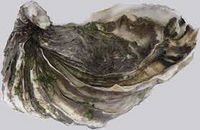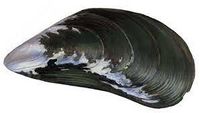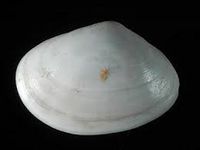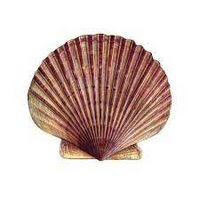Difference between revisions of "Ocean acidification"
Dronkers J (talk | contribs) |
Dronkers J (talk | contribs) |
||
| Line 1: | Line 1: | ||
| + | |||
{{ | {{ | ||
Definition|title=Ocean acidification | Definition|title=Ocean acidification | ||
| Line 9: | Line 10: | ||
==Influence of ocean acidification on a few bivalve species== | ==Influence of ocean acidification on a few bivalve species== | ||
| + | |||
| + | ===Oyster ''Magallana gigas'' and mussel ''Mytilus'' spp.=== | ||
The following is extracted from (Mele et al., 2023<ref>Mele, I., McGill, R.A.R., Thompson, J., Fennell, J. and Fitzer, S. 2023. Ocean acidification, warming and feeding impacts on biomineralization pathways and shell material properties of ''Magallana gigas'' and ''Mytilus'' spp. Marine Environmental Research 186, 105925</ref>): | The following is extracted from (Mele et al., 2023<ref>Mele, I., McGill, R.A.R., Thompson, J., Fennell, J. and Fitzer, S. 2023. Ocean acidification, warming and feeding impacts on biomineralization pathways and shell material properties of ''Magallana gigas'' and ''Mytilus'' spp. Marine Environmental Research 186, 105925</ref>): | ||
| Line 15: | Line 18: | ||
As the ocean’s pH decreases, the extent of the effect of ocean acidification is dependent on the shell structure and composition of the organism. Calcium carbonate can present most commonly as one of two polymorphs, calcite being the stable hexagonal form, and aragonite being considered metastable and more vulnerable to ocean acidification. | As the ocean’s pH decreases, the extent of the effect of ocean acidification is dependent on the shell structure and composition of the organism. Calcium carbonate can present most commonly as one of two polymorphs, calcite being the stable hexagonal form, and aragonite being considered metastable and more vulnerable to ocean acidification. | ||
| + | |||
| + | {| border="0" align="right" | ||
| + | |- | ||
| + | | valign="top"| | ||
| + | [[File:MagallanaGigas.jpg|thumb|left|200px|''Magallana gigas'']] | ||
| + | | valign="top"| | ||
| + | [[File:Mytilus Edulis.jpg|thumb|left|200px|''Mytilus edulis'']] | ||
| + | |} | ||
Both the mussel ''Mytilus'' species (spp.) and the oyster ''Magallana gigas'' form calcite layers, but ''Mytilus'' spp. also forms aragonite on the inner shell layer. Although the two polymorphs share the same chemical formula, the different atomic arrangement of aragonite increases susceptibility to ocean acidification, compared to calcite. ''Mytilus'' spp. and ''Magallana gigas'' together account for 46% of global mollusc production within the aquaculture industry. Previous research has shown that increasing food supply to molluscs during ocean acidification experiments can limit shell corrosion and increase shell growth. | Both the mussel ''Mytilus'' species (spp.) and the oyster ''Magallana gigas'' form calcite layers, but ''Mytilus'' spp. also forms aragonite on the inner shell layer. Although the two polymorphs share the same chemical formula, the different atomic arrangement of aragonite increases susceptibility to ocean acidification, compared to calcite. ''Mytilus'' spp. and ''Magallana gigas'' together account for 46% of global mollusc production within the aquaculture industry. Previous research has shown that increasing food supply to molluscs during ocean acidification experiments can limit shell corrosion and increase shell growth. | ||
| Line 20: | Line 31: | ||
When seawater temperature rises, ''Mytilus'' spp. appear to rely on metabolically sourced carbon for shell calcite potentially from extrapallial fluid (fluid from outside the mantle) rather than from mantle tissue or from the feed under ocean acidification. The altered biomineralization pathway in ''Mytilus'' spp. into the shell calcite layer, is sufficient to maintain the growth of the shell, as well as its thickness and hardness. On the other hand, ''Mytilus'' spp. increases environmentally sourced carbon for aragonite under low pH conditions. This response is sufficient to maintain and increase shell thickness in high water temperature scenarios. Low pH also affects ''M. gigas'' from a feeding and nutrient perspective shown by variation in mantle nitrogen isotopes, but biomineralization pathway is maintained along with growth. Thus, the response to ocean acidification and extra feeding results appear species-specific according to the carbon sourcing preference of ''Mytilus'' spp. and ''M. gigas''. In a natural scenario, plankton blooms would be more beneficial to ''M. gigas'', as in this study shows overall better shell performance and resilience than ''Mytilus'' spp. | When seawater temperature rises, ''Mytilus'' spp. appear to rely on metabolically sourced carbon for shell calcite potentially from extrapallial fluid (fluid from outside the mantle) rather than from mantle tissue or from the feed under ocean acidification. The altered biomineralization pathway in ''Mytilus'' spp. into the shell calcite layer, is sufficient to maintain the growth of the shell, as well as its thickness and hardness. On the other hand, ''Mytilus'' spp. increases environmentally sourced carbon for aragonite under low pH conditions. This response is sufficient to maintain and increase shell thickness in high water temperature scenarios. Low pH also affects ''M. gigas'' from a feeding and nutrient perspective shown by variation in mantle nitrogen isotopes, but biomineralization pathway is maintained along with growth. Thus, the response to ocean acidification and extra feeding results appear species-specific according to the carbon sourcing preference of ''Mytilus'' spp. and ''M. gigas''. In a natural scenario, plankton blooms would be more beneficial to ''M. gigas'', as in this study shows overall better shell performance and resilience than ''Mytilus'' spp. | ||
| + | ===White furrow shell ''Abra alba''=== | ||
| + | |||
| + | [[File:AbraAlba.jpg|thumb|right|200px|''Abra alba'']] | ||
| + | |||
| + | A study of Vlaminck et al. (2022<ref>Vlaminck, E., Moens, T., Vanaverbeke, J. and Van Colen, C. 2022. Physiological response to seawater pH of the bivalve Abra alba, a benthic ecosystem engineer, is modulated by low pH. Marine Environmental Research 179, 105704</ref>) on the physiological response of the white furrow shell ''Abra alba'' to three pH treatments (pH = 8.2, pH = 7.9 and pH = 7.7) showed no pH effect on survival. However, lowered respiration and calcification rates, decreased energy intake (lower absorption rate) and increased metabolic losses (increased excretion rates) occurred at pH ∼ 7.7. These physiological responses resulted in a negative Scope for Growth and a decreased condition index at this pH. This suggests that the physiological changes may not be sufficient to sustain survival in the long term, which would undoubtedly translate into consequences for ecosystem functioning. <br clear=all> | ||
| + | |||
| + | ===Peruvian scallop ''Argopecten purpuratus''=== | ||
| + | |||
| + | [[File:ArgopectenPurpuratus.jpg|thumb|right|200px|''Argopecten purpuratus'']] | ||
| − | + | Along the Peruvian coast, natural conditions of low pH (7.6–8.0) are encountered in the habitat of the Peruvian scallop ''Argopecten purpuratus'', as a consequence of the nearby coastal upwelling influence. During 28 days, scallops (initial mean height = 14 mm) were exposed to two contrasted pH conditions: a control with unmanipulated seawater presenting pH conditions similar to those found in situ (pHT = 7.8) and a treatment, in which CO2 was injected to reduce pH to 7.4. At the end of the experiment, shell height and weight, and growth and calcification rates were reduced about 6%, 20%, 9%, and 10% respectively in the low pH treatment. Mechanical properties, such as microhardness were positively affected in the low pH condition and crushing force did not show differences between pH treatments. Final soft tissue weights were not significantly affected by low pH. This study provides evidence of low pH change shell properties increasing the shell microhardness in Peruvian scallops, which implies protective functions (Cordova-Rodriguez et al., 2022<ref>Cordova-Rodríguez, K., Flye-Sainte-Marie, J., Fernandez, E., Graco, M., Rozas, A. and Aguirre-Velarde, A. 2022., Effect of low pH on growth and shell mechanical properties of the Peruvian scallop ''Argopecten purpuratus'' (Lamarck, 1819). Marine Environmental Research 177, 105639</ref>). <br clear=all> | |
Revision as of 17:41, 7 August 2023
Definition of Ocean acidification:
The process whereby atmospheric carbon dioxide dissolves in seawater producing carbonic acid, which subsequently lowers pH of surrounding seawater; widely thought to be happening on a global scale.
This is the common definition for Ocean acidification, other definitions can be discussed in the article
|
Contents
Note
Other processes also contribute to acidification, especially in eutrophic coastal waters: decomposition of organic material, nitrification in surface water (promoted by sewage discharge) and oxidation processes in sediments[1].
Influence of ocean acidification on a few bivalve species
Oyster Magallana gigas and mussel Mytilus spp.
The following is extracted from (Mele et al., 2023[2]):
Climate change and ocean acidification, induced by rising atmospheric carbon dioxide (CO2), are global phenomena which threaten marine organisms biomineralizing calcium carbonate (CaCO3) shells. The average acidity of ocean surface waters is expected to decrease by 0.14–0.43 units (i.e., a decrease in pH from about 8.1 to about 7.7 - 7.95) with a simultaneous increase of +2 oC and +4 oC in sea surface temperature by 2100. Consequently, the seawater bicarbonate (HCO-3) and carbonic acid (H2CO3) equilibrium is affected causing under-saturation of oceanic calcite and aragonite worldwide.
As the ocean’s pH decreases, the extent of the effect of ocean acidification is dependent on the shell structure and composition of the organism. Calcium carbonate can present most commonly as one of two polymorphs, calcite being the stable hexagonal form, and aragonite being considered metastable and more vulnerable to ocean acidification.
Both the mussel Mytilus species (spp.) and the oyster Magallana gigas form calcite layers, but Mytilus spp. also forms aragonite on the inner shell layer. Although the two polymorphs share the same chemical formula, the different atomic arrangement of aragonite increases susceptibility to ocean acidification, compared to calcite. Mytilus spp. and Magallana gigas together account for 46% of global mollusc production within the aquaculture industry. Previous research has shown that increasing food supply to molluscs during ocean acidification experiments can limit shell corrosion and increase shell growth.
When seawater temperature rises, Mytilus spp. appear to rely on metabolically sourced carbon for shell calcite potentially from extrapallial fluid (fluid from outside the mantle) rather than from mantle tissue or from the feed under ocean acidification. The altered biomineralization pathway in Mytilus spp. into the shell calcite layer, is sufficient to maintain the growth of the shell, as well as its thickness and hardness. On the other hand, Mytilus spp. increases environmentally sourced carbon for aragonite under low pH conditions. This response is sufficient to maintain and increase shell thickness in high water temperature scenarios. Low pH also affects M. gigas from a feeding and nutrient perspective shown by variation in mantle nitrogen isotopes, but biomineralization pathway is maintained along with growth. Thus, the response to ocean acidification and extra feeding results appear species-specific according to the carbon sourcing preference of Mytilus spp. and M. gigas. In a natural scenario, plankton blooms would be more beneficial to M. gigas, as in this study shows overall better shell performance and resilience than Mytilus spp.
White furrow shell Abra alba
A study of Vlaminck et al. (2022[3]) on the physiological response of the white furrow shell Abra alba to three pH treatments (pH = 8.2, pH = 7.9 and pH = 7.7) showed no pH effect on survival. However, lowered respiration and calcification rates, decreased energy intake (lower absorption rate) and increased metabolic losses (increased excretion rates) occurred at pH ∼ 7.7. These physiological responses resulted in a negative Scope for Growth and a decreased condition index at this pH. This suggests that the physiological changes may not be sufficient to sustain survival in the long term, which would undoubtedly translate into consequences for ecosystem functioning.
Peruvian scallop Argopecten purpuratus
Along the Peruvian coast, natural conditions of low pH (7.6–8.0) are encountered in the habitat of the Peruvian scallop Argopecten purpuratus, as a consequence of the nearby coastal upwelling influence. During 28 days, scallops (initial mean height = 14 mm) were exposed to two contrasted pH conditions: a control with unmanipulated seawater presenting pH conditions similar to those found in situ (pHT = 7.8) and a treatment, in which CO2 was injected to reduce pH to 7.4. At the end of the experiment, shell height and weight, and growth and calcification rates were reduced about 6%, 20%, 9%, and 10% respectively in the low pH treatment. Mechanical properties, such as microhardness were positively affected in the low pH condition and crushing force did not show differences between pH treatments. Final soft tissue weights were not significantly affected by low pH. This study provides evidence of low pH change shell properties increasing the shell microhardness in Peruvian scallops, which implies protective functions (Cordova-Rodriguez et al., 2022[4]).
See also
Review on the impacts of ocean stratification by Kroeker et al. (2014[5]).
An extensive article on ocean acidification can be found in the Wikipedia: Ocean acidification.
References
- ↑ Wallace, R.B. and Gobler, C.J. 2021. The role of algal blooms and community respiration in controlling the temporal and spatial dynamics of hypoxia and acidification in eutrophic estuaries. Marine Pollution Bulletin 172, 12908
- ↑ Mele, I., McGill, R.A.R., Thompson, J., Fennell, J. and Fitzer, S. 2023. Ocean acidification, warming and feeding impacts on biomineralization pathways and shell material properties of Magallana gigas and Mytilus spp. Marine Environmental Research 186, 105925
- ↑ Vlaminck, E., Moens, T., Vanaverbeke, J. and Van Colen, C. 2022. Physiological response to seawater pH of the bivalve Abra alba, a benthic ecosystem engineer, is modulated by low pH. Marine Environmental Research 179, 105704
- ↑ Cordova-Rodríguez, K., Flye-Sainte-Marie, J., Fernandez, E., Graco, M., Rozas, A. and Aguirre-Velarde, A. 2022., Effect of low pH on growth and shell mechanical properties of the Peruvian scallop Argopecten purpuratus (Lamarck, 1819). Marine Environmental Research 177, 105639
- ↑ Kroeker, K.J., Kordas, R.L., Crim, R., Hendriks, I.E., Ramajos, L., Singh, G,S, Duartes, C.M. and Gattusa, J-P. 2014. Impacts of ocean acidification on marine organisms: quantifying sensitivities and interaction with warming. Global Change Biology 19: 1884–1896, doi: 10.1111/gcb.12179. https://onlinelibrary.wiley.com/doi/epdf/10.1111/gcb.12179



